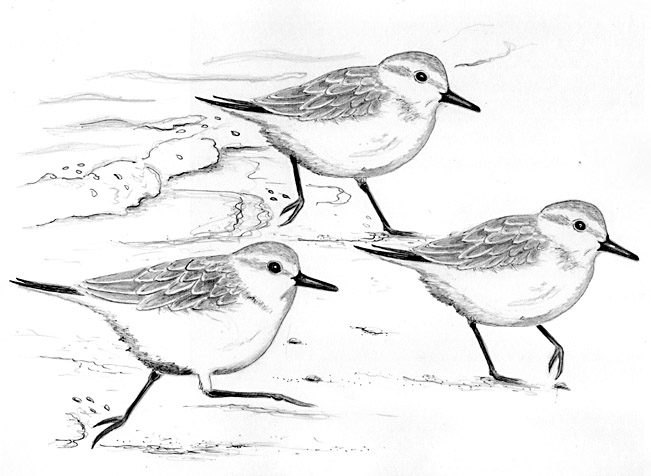
Dear Bird Folks,
While visiting a Cape beach recently (mid-August) I observed a flock of thirty Sanderlings feeding along the water’s edge. As I watched I noticed two rather aggressive Sanderlings get all fluffed-up and chase away the others. The aggressors would return to eating until the others came back, at which time they chased them away once more. With the nesting season long over, why were these birds so aggressive? Were they practicing for next year’s breeding encounters?
– Vicky, Iowa City, IA
One thing, Vicky,
Thanks for writing me that nice note, but next time keep in mind that I have trouble reading other people’s handwriting. Believe me, this is not a complaint. I would never complain about someone else’s handwriting, especially when compared to mine. Doctors, monkeys, and seismographs all write better than I do. But there were a few words I had a little trouble with. Instead of Sanderlings, I originally thought you were asking about a flock of “sardines” chasing each other on the beach and I don’t want to even tell you what I thought “fluffed” was.
Whether they know it or not most people, who have been to an ocean beach, have seen Sanderlings. While most other shorebirds spend their days feeding on gooey mudflats, Sanderlings like running around on sandy beaches, just like we do. And when I say “running,” that’s exactly what they like to do. Sanderlings are those little sandpipers that we see playing tag with the waves. Many of us also like to play tag with the waves but Sanderlings are much better at it than we are. When Sanderlings play wave tag they don’t end up with wet shoes and socks every single time. Right now many of you are thinking: “Who wears shoes and socks on the beach?” Us geeky bird watchers, that’s who. As if you had to ask.
Playing wave tag may seem like a fun game to us, but it’s all business to Sanderlings. As the waves recede, an assortment of minute aquatic creatures is temporarily exposed. With the speed of Olympic sprinters, or women at the Filene’s Basement annual bridal sale, the Sanderlings rush in, grab whatever they can and get out before the next wave comes crashing in. If the birds are fast enough, they’ll snag themselves a few morsels of food, and occasionally, a lovely white wedding dress.
You won’t find a Sanderling nest on Cape Cod, or Iowa City for that matter. Sanderlings nest well above the Arctic Circle, where the nesting season is very short. In order to make the most of what little time they have, the birds have to be creative. Some female Sanderlings will lay a clutch of eggs, but instead of sitting on them, she will have her mate sit on them. She then will go off and lay a second batch of eggs that she incubates herself. And if nesting conditions are just right, she may even hook up with another neighboring male and lay a third clutch of eggs, which the new male will take care of. Apparently, Sanderlings are both fast and easy.
Baby Sanderlings can feed themselves from day one, but the parents, or parent, still need to remain with the little ones to keep them warm. During the day the young birds feed on the north country’s abundant supply of insects, while at night they cozy up to an adult. After about three weeks of nonstop baby-sitting, the adult birds have had enough. One day, without so much as a hug good-bye or a list of instructions, the parents up and leave. Their kids are now all alone at the top of the world, forced to figure things out for themselves. For several days the young Sanderlings mill about with other juveniles, wondering what to do next. Then they too get the urge to migrate. With a push from their newly developed wings the young birds leave their nesting grounds and head off to a place they have never been before, which, in many cases, is Cape Cod.
Out-side of the breeding season Sanderlings are gregarious birds. They feed together in small flocks and roost together in larger flocks. Most Sanderlings get along quite well, but there are a few birds that, again, like us humans, don’t play nice with others. For whatever reason some Sanderlings, both male and female, try to defend their food sources. They constantly chase others away from their feeding areas, even when there is enough grub to go around.
The bossy birds you saw weren’t trying to set themselves up for next year’s breeding season; they were just control freaks. I don’t know if this aggressive behavior has any long-range benefits, but I do know that the Sanderling population is in trouble. As our beaches become more and more popular with people, ORVs, dogs and birders, the birds are finding fewer places where they can eat and rest. But, that’s another column for another day.
I’m glad you noticed the very active Sanderlings, Vicky. They are fun birds to watch. I’m also glad that I figured out you weren’t asking about sardines. I don’t know much about them and I would have had to consult an expert for help, and that wouldn’t have been good. The only sardine experts I know are gulls and Norwegians, and I can’t understand either one.